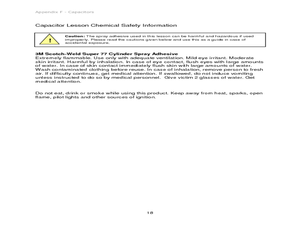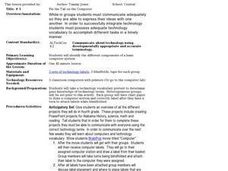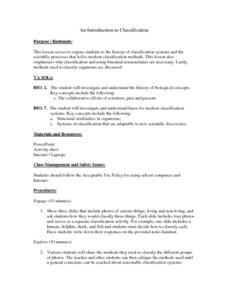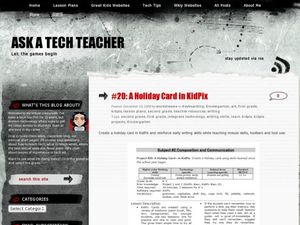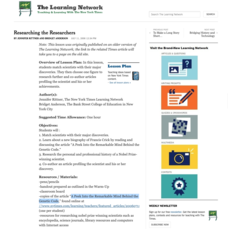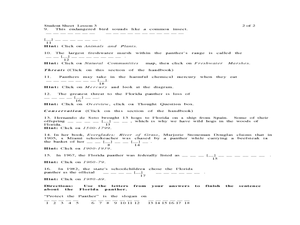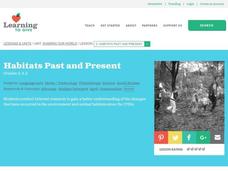Curated OER
Capacitors: What Are They?
Students discover how capacitors help store data. In this computer science lesson, students investigate how capacitors can store an electronic charge, eventually helping computers store data. Students create their own...
Curated OER
Using computers in the content area
Students practice grade appropriate computer basics and integrate them into the curriculum areas. in this technology lesson, students understand correct behaviors while using the computer. Students become familiar with the Internet...
Curated OER
Science in History Part I: the Abacus To the Modern Computer
In this math information worksheet, students read one page factual accounts of the early math inventions of the abacus, the calculator and early computers. There are 40 questions to answer about the reading.
Curated OER
Human Computer Game
Students view the "Parts of a Computer" Power Point presentation then they view the inside of a computer and break down each operating system and its job. They compare and contrast the difference between human and computer parts that...
Curated OER
Parts of a Computer
Students, after identifying the parts of a computer, and categorizing the parts by functions (input, output, process, and storage), explore how all the parts of a computer work together. They compare/contrast the differences between...
Curated OER
Pin the Tail on the Computer
Students identify the basic components of the computer system. They watch a Brain Pop movie about computers and then draw a "vocabulary label" from a basket. The student is blindfolded and sticks the label on a picture of a computer....
Curated OER
Getting Started With Java-Background
Students study the history of computers including hardware and software, binary representation of data and examine the beginnings of programming languages. They investigate the development of software and the fundamentals of...
Curated OER
Explorit's Computing and Internet History Quiz
In this online interactive computing and Internet history quiz worksheet, students respond to 10 questions. Students may check their answers to checked for accuracy.
Curated OER
Feature Column: Virtual Field Trips
Students discover ways to stay healthy by utilizing Internet education software. In this computer technology lesson, students investigate Internet programs that simulate a field trip by showing images and video. Students...
Curated OER
Hunt the Fact Monster
In this Fact Monster search engine worksheet, students access the Internet to a specific search engine to find the answers to five questions with multiple choice answers.
Curated OER
Getting Started with Java
Students discuss the history of computers and describe how hardware and software make up computer architecture. They review the binary system and the evolution of programming languages then discuss the fundamental concepts of object...
Curated OER
Exploring the Smithsonian
Students explore the Smithsonian Institute. For this technology and history lesson, students work in pairs to complete a worksheet by researching questions using the Smithsonian Institute website.
Curated OER
An Introduction to Classification
Sixth graders explore, analyze and study the history of classification systems and the scientific processes that influenced modern classification methods. They evaluate why classification and binomial nomenclature are necessary to the...
Curated OER
Introduction to Computing and Project Development
Students use a computer and math to complete a science project. They review a brief history of computers as well as information on different operating formats will be included. In addition, students complete an overview of the hardware...
Curated OER
A Holiday Card in KidPix
Students create a holiday card using computer software. In this computer card making lesson, students design an original holiday card using a variety of tools. Students navigate the software utilizing various tools.
Curated OER
Scooting Along!
Young scholars investigate how Newton's Third Law affects vehicle design. In this Newton's Third Law lesson plan, students use a web site to research Newton, his third law, and how to design a vehicle that uses a balloon for power. They...
The New York Times
Researching the Researchers
Young scholars match scientists with their major discoveries, choose one figure to research further, and co-author articles profiling the scientist and his or her achievements.
Curated OER
Volcanoes
In this volcanoes worksheet, students click on the links in blue to find the answers to fourteen facts about volcanoes. Students answer each question with a short answer response.
Curated OER
Zeros and Ones
Students review counting, the number system and the decimal number system. They rotate through three stations, "How RAM Works, "Binary Numbers" and "Binary Letters." They complete three separate worksheets to check for complete...
Curated OER
Creating Animal Prints
Students investigate the habits of animals by studying their prints. In this animal life instructional activity, students investigate the different types of tracks left from animals by researching the Internet. Students...
Curated OER
Become an Expert
Students practice their researching techniques by preparing a presentation with little notice. In this information research lesson, students utilize the Internet to research one of several subtopics concerning panthers....
Curated OER
Panther Scavenger Hunt
Students research a website to learn about the Florida panther. In this animal research lesson, students use the scavenger hunt directions to search a website about Florida panthers. Students also solve word puzzles within the activity.
Curated OER
Habitats Past and Present
Students explore the changes in animal habitats. In this ecosystem lesson, students use the Internet to explore the changes in the environment since the 1700's. Students complete a Venn diagram to compare the differences in the animal...
Curated OER
Visit My Class Wikis
Students visit the links on the blog site to learn about class wikis. In this technology integration lesson, students visit the links to view class wikis.
